Exhibition dates: 4th October 2015 – 18th January 2016

Otto Dix (German, 1891-1969)
Card Players (Kartenspieler)
1920
Drypoint
19 7/8 × 13 1/16 in. (50.5 × 32.5cm)
Los Angeles County Museum of Art, the Robert Gore Rifkind Center for German Expressionist Studies, purchased with funds provided by the Robert Gore Rifkind Foundation, Beverly Hills, CA, and Helgard Field-Lion and Irwin Field
© 2015 Artists Rights Society (ARS), New York/VG Bild-Kunst, Bonn
Photo © 2015 Museum Associates/LACMA
If I had to nominate one period of art that is my favourite, it would be European avant-garde art between 1919-1939. The sense of renewed creativity, inventiveness, and sustained enquiry into the nature of things by artists, this texture of reality, just fascinates me. A hyper-sensory, objective sobriety, yes, but more – an opposite, apposite expression of critical, cultural opprobrium that sticks its proboscis into mental and machinic spaces.
The relations between the physical and the psychic are evidenced during this period “as a general movement and multiplicity, rather than just a series of mechanisms.” What surrounds the metaphysical body, its environment, is enacted as a performance upon the body through a “continuous set of relations, multiplicities, speeds, connections. Bodies are only distinguished by certain singularities, which are clarifications of expression drawing together certain multiplicities, under the aegis of an event.” Bodies are (en)acted upon. Conversely, “Just as bodies can be seen as machinic, so too does the machinic depend upon bodies wrought out of vibration [of energy, of ideas] by clarity of expression of events.” They are folded and refolded into each other, in a series of multiplicities and intensities – of architecture and art, of sex and gender, of flagellation and flight – so that there is a ‘synthesis of heterogeneties’, or hetero(gene)ties that evidence the DNA of our becoming, our diverse difference, our heterogeneic alterity. This folding, this vibration of energy, these clear zones of expression and performance produce this dazzling, de(gene)rate art.1
In this huge posting I have tried to sequence the machinic (the spelling auto correct keeps changing it to “mechanic” which is quite ironic) with the figurative, the painting of architecture with the architectural photograph; the photograph of the sewing machine with the painting of the Paper Machine; the distorted, etched face with the photographic war damaged face; the Modernist housing estate with the alienation of the Picture of Industry. You get the picture. One is folded into the other as performance, as vibration of energy, as (destructive, or creative) ritual of re/production. And there we have the gay lovers, the first transgender woman who dies after operations on her body, the climax – in an erotic sense – of the scar on the woman’s leg in Friedrich Seidenstücker’s Untitled (c. 1930, below) or the blood lines of the eyeball in Herbert Ploberger’s Self-Portrait with Ophthalmological Models (c. 1928-1930, below). Or the cool objectiveness of Sander’s photographs – Coal Carrier, Painter’s Wife, The Architect – against the detached titles (The Jeweller, Portrait of a Lawyer, Portrait of an Architect, name of person secondary) but outrageous colours and distortions / elongations of the painted portraits. Fascinating archetypal, subjective / objective correlation.
This is a mad, dangerous, exciting world in which these artists lived, which they mapped and depicted in all its glorious intensity. Flowering one minute, dead the next.
Dr Marcus Bunyan
Many thankx to the Los Angeles County Museum of Art for allowing me to publish the photographs in the posting. Please click on the photographs for a larger version of the image.
Further reading: New Objectivity: Modern German Art in the Weimar Republic, 1919-1933 (135kb pdf)
1/ Some of these ideas came from Murphie, Andrew. “Computers are not theatre: the machine in the ghost in Gilles Deleuze and Félix Guattari’s thought,” in Genosko, Gary (ed.,). Deleuze and Guattari: Critical Assessments of Leading Philosophers. London, Routledge, 2001, pp. 1311-1312
“German Expressionism is an art which above all, celebrated, inwardness.”
“There’s no contradiction between being a Fascist and being an artist… I’m sorry but there isn’t. It happens that not very many good artists have been Nazis.”
Robert Hughes
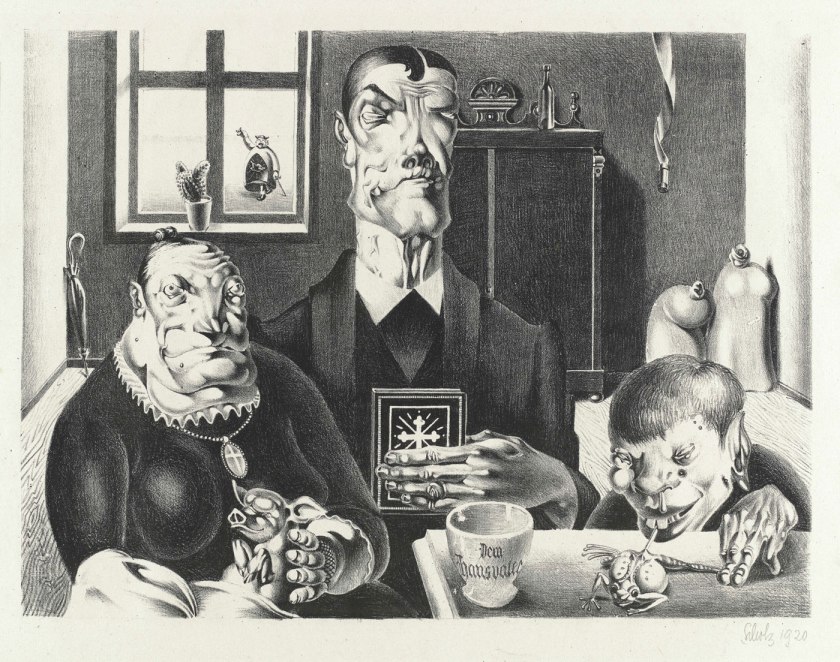
Georg Scholz (German, 1890-1945)
Industrial Peasants (Industriebauern)
1920
Lithograph on wove paper
15 1/2 × 19 in. (39.4 × 48.3cm)
Los Angeles County Museum of Art, purchased with funds provided by the Robert Gore Rifkind Foundation, Beverly Hills, CA, and the Modern Art Deaccession Fund
© 2015 Artists Rights Society (ARS), New York/VG Bild-Kunst, Bonn, photo
© Museum Associates/LACMA

Otto Dix (German, 1891-1969)
Sex Murder (Lustmord)
1922
Etching
10 7/8 x 13 5/8 in. (27.5 x 34.6cm)
© 2015 Artists Rights Society (ARS), New York/VG Bild-Kunst, Bonn
Photo courtesy Galerie Nierendorf, Berlin
Willie Vicarage, suffering facial wounds in the Battle of Jutland 1916 Naval Battle was one of the first men to receive facial reconstruction using plastic surgery. Doctor Harold Gillies created the “tubed pedicle” technique that used a flap of skin from the chest or forehead and swung it into place over the face. The flap remained attached but was stitched into a tube, keeping the original blood supply intact and dramatically reducing the infection rate.
This photograph is not in the exhibition, but I have included it to show an actual case study of facial reconstruction during WW1. While there were few books in Britain about the war, soldiers injuries and facial reconstruction, Otto Dix produced his seminal portfolio Der Krieg (War) (below).
“Otto Dix was born in 1891 in Untermhaus, Thuringia, the son of an ironworker. He initially trained in Gera and at the Dresden School of Arts and Crafts as a painter of wall decorations and later taught himself how to paint on canvas. He volunteered as a machine-gunner during World War I and in the autumn of 1915 he was sent to the Western Front. He was at the Somme during the major allied offensive of 1916.
After the war he studied at the academies of Dresden and Dusseldorf. Together with George Grosz, he was one of the leading exponents of the artistic movement Die Neue Sachlichkeit (New Objectivity), a form of social realist art which unsentimentally examined the decadence and underlying social inequality of post-war German society. With the rise of the National Socialists in 1933, Dix was dismissed from his teaching post at the Dresden Academy. He moved south to Lake Constance and was only allowed to continue practising as an artist after he agreed to relinquish overtly political subject matter in favour of landscape painting. Dix was conscripted into the army during World War II and in 1945 was captured and put into a prisoner of war camp. He returned to Dresden after the war where his paintings became more religiously reflective of his war-time experiences. He died in 1969.
Der Krieg (War) 1924 arose out of Dix’s own experiences of the horrors of war. As outlined above, he had volunteered for service in the army and fought as a machine-gunner on the Western Front. He was wounded a number of times, once almost fatally. War profoundly affected him as an individual and as an artist, and he took every opportunity, both during his active service and afterwards, to document his experiences. These experiences would become the subject matter of many of his later paintings and are central to the Der Krieg cycle.
Der Krieg itself, as a cycle of prints (51 in total), is consciously modelled on Goya’s (1746-1828) equally famous and equally devastating Los Desastres de la Guerra (The disasters of war). Los Desastres detailed Goya’s own account of the horrors of the Napoleonic invasion and the Spanish War of Independence from 1808 to 1814. Goya’s cycle of 82 etchings, which he worked on for a decade after the Spanish War of Independence were not, however, published until 1863, long after his death.
Like Los Desastres, Der Krieg uses a variety of etching techniques and does so with an equally astonishing facility. Similarly, it exploits the cumulative possibilities of a long sequence of images and mirrors Goya’s unflinching, stark realism in terms of its fundamental presentation. GH Hamilton describes Dix’s cycle as ‘perhaps the most powerful as well as the most unpleasant anti-war statements in modern art… It was truly this quality of unmitigated truth, truth to the most commonplace and vulgar experiences, as well as the ugly realities of psychological experience, that gave his work a strength and consistency attained by no other contemporary artist, not even by (George) Grosz…’ It has become a commonplace to see this cycle as an admonition against the barbarity of war. And there is no doubt that as a human document it is a powerful cautionary work. At a psychological level, however, its truth goes deeper than this. Dix was both horrified and fascinated by the experience of war…
This nightmarish, hallucinatory quality pervades all of the Der Krieg images. Paradoxically, there is also a quality of sensuousness, an almost perverse delight in the rendering of horrific detail, which indicates that there was perhaps, in Dix’s case, an almost addictive quality to the hyper-sensory input of war. In terms of the general corpus of Dix’s work, Der Krieg occupies a central place amongst the large number of paintings and works-on-paper devoted to the theme of war. The work is astonishingly powerful and, as stated above, it remains one of the most powerful indictments of war ever conceived. It is universally regarded as one of the great masterpieces of twentieth century. Dix’s oeuvre as a whole, and Der Krieg in particular, was hugely influential on a number of other twentieth century artist such as Ben Shahn, Pablo Picasso and Robert Motherwell.”
Mark Henshaw. “The Art of War: Otto Dix’s Der Krieg [War] cycle 1924,” on the National Gallery of Australia website [Online] Cited 07/01/2016
Education resource material: beauty, truth and goodness in Dix’s War (250kb pdf)

Otto Dix (German, 1891-1969)
Skin Graft (Transplantation) from the portfolio War (Der Krieg)
1924
Etching with aquatint on copperplate paper
18 11/16 x 13 7/8 in. (47.5 x 35.2cm)
Los Angeles County Museum of Art, the Robert Gore Rifkind Center for German Expressionist Studies
© 2015 Artists Rights Society (ARS), New York/VG Bild-Kunst, Bonn
Photo © Museum Associates/LACMA
The Los Angeles County Museum of Art (LACMA) presents New Objectivity: Modern German Art in the Weimar Republic, 1919-1933, the first comprehensive show in the United States to explore the themes that characterize the dominant artistic trends of the Weimar Republic. Organised in association with the Museo Correr in Venice, Italy, this exhibition features nearly 200 paintings, photographs, drawings, and prints by more than 50 artists, many of whom are little known in the United States. Key figures – Otto Dix, George Grosz, Christian Schad, August Sander, and Max Beckmann – whose heterogeneous careers are essential to understanding 20th century German modernism, are presented together with lesser known artists, including Herbert Ploberger, Hans Finsler, Georg Schrimpf, Heinrich Maria Davringhausen, Carl Grossberg, and Aenne Biermann, among others. Special attention is devoted to the juxtaposition of painting and photography, offering the rare opportunity to examine both the similarities and differences between the movement’s diverse media.
During the 14 years of the Weimar Republic (1919-1933), artists in Germany grappled with the devastating aftermath of World War I: the social, cultural, and economic effects of rapid modernisation and urbanisation; staggering unemployment and despair; shifting gender identities; and developments in technology and industry. Situated between the end of World War I and the Nazi assumption of power, Germany’s first democracy thrived as a laboratory for widespread cultural achievement, witnessing the end of Expressionism, the exuberant anti-art activities of the Dadaists, the establishment of the Bauhaus design school, and the emergence of a new realism.
This new turn to realism, best recognised by a 1925 exhibition in Mannheim, Neue Sachlichkeit (of which New Objectivity is the English translation), has at times been called Post-Expressionism, neo-naturalism, Verism, and Magic Realism. The diverse group of artists associated with this new realism was not unified by manifesto, political tendency, or geography, they shared a skepticism regarding the direction Germany society was taking in the years following World War I and an awareness of the human isolation these changes brought about.
Germany’s financial, sociopolitical, and emotional defeat in WWI took a profound toll on the nation. In contrast to their Expressionist predecessors – who had enthusiastically embraced the war before confronting its harrowing realities on the battlefield – practitioners of the New Objectivity movement were disillusioned with the complex realities of the new Germany. Digressing from Expressionism’s penchant for bold, abstract subjectivity, the Weimar Republic’s burgeoning group of artists favoured realism, precision, objective sobriety, and the appropriation of Old Master painting techniques, including a nostalgic return to portraiture and heightened attention to the appearance of surface…
Hans Finlser (German, 1891-1972)
Eggs on a Plate (Eier auf Teller)
1929
Gelatin silver print
9 9/16 x 6 13/16 in. (24.3 x 17.3cm)
Kunstmuseum Moritzburg Halle (Saale)
© 2015 Finsler Estate, Stiftung Moritzburg Halle (Saale), Kunstmuseum des Landes Sachsen-Anhalt
Hans Finsler (German, 1891-1972)
Electric Bulb with Parts of the Socket (Elektrische Birne mit Teilen der Fassung)
1928
Vintage print
8 5/8 x 5 7/8 in. (21.9 x 14.9cm)
Kunstmuseum Moritzburg Halle (Saale)
© 2015 Finsler Estate, Stiftung Moritzburg Halle (Saale), Kunstmuseum des Landes Sachsen-Anhalt
Born in Munich, Hans Finsler was a gifted teacher of photography in Switzerland from the 1920s to the 1950s, where he taught students the vocabulary of modernism and its strength of vision. Finsler was also well-known for his stylish and innovative commercial work reflecting the contemporary Neue Sachlichkeit (New Vision) aesthetic of describing machinery, architecture and manufactured products with clarity and respect. His private work, however, was more profound and philosophical. He experimented tirelessly with simple and elemental forms, developing theories of motion and stillness with highlights and shadows, often using eggs as his principal subject matter. Finsler’s photographs were exhibited in the important exhibition Film und Foto in Stuttgart in 1929.
Carl Grossberg (German, 1894-1940)
The Yellow Boiler (Der Gelbe Kessel)
1933
Oil on wood
37 x 29 in. (94 x 73.7cm)
Von der Heydt-Museum Wuppertal, Germany
Photo courtesy Von der Heydt-Museum Wuppertal, Germany
Carl Grossberg (German, 1894-1940)
The Paper Machine (Die Papiermaschine)
1934
Oil on wood
35 7/16 x 45 11/16 in. (90 x 116cm)
Private collection
Photo by Benjamin Hasenclever, Munich
Wanda von Debschitz-Kunowski (German, 1870-1935)
Sewing Machine (Nähmaschine)
c. 1930
Photograph
7 7/16 x 5 5/16 in. (18.9 x 15.1cm)
Galerie Berinson, Berlin
Photo: Galerie Berinson, Berlin
Wanda von Debschitz-Kunowski was a German portrait photographer based in Munich. From 1902 through 1914, she worked at the Debschitz School, first in the metal workshop (1902-1905) and later teaching photography (1905-1914). By 1921, she had opened her own photography studio in Berlin. Her work included nudes, and dancers.
Albert Renger-Patzsch (German, 1897-1966)
Flat Irons for Shoe Manufacture, Fagus Factory I (Bügeleisen für Schuhfabrikation, Fagus-Werk, Alfeld)
1926
Gelatin silver print
9 x 6 5/8 in. (22.9 x 16.8cm)
The J. Paul Getty Museum, Los Angeles
© 2015 Albert Renger-Patzsch Archiv/Ann u. Jürgen Wilde, Zülpich/Artists Rights Society (ARS), New York
“We still don’t sufficiently appreciate the opportunity to capture the magic of material things. The structure of wood, stone, and metal can be shown with a perfection beyond the means of painting… To do justice to modern technology’s rigid linear structure… only photography is capable of that.”
So wrote Albert Renger-Patzsch in 1927 about the camera’s innate ability to depict the Industrial Age. Here he studied the materials of identically shaped, finished wooden handles and industrially produced steel heads, while also representing the flatirons as an army of tools standing at attention like bowling pins. Renger-Patzsch’s photograph celebrates the beauty of the commonplace object.
Text from the J. Paul Getty Museum website
Renger-Patzsch was born in Würzburg and began making photographs by age twelve. After military service in the First World War he studied chemistry at Dresden Technical College. In the early 1920s he worked as a press photographer for the Chicago Tribune before becoming a freelancer and, in 1925, publishing a book, The choir stalls of Cappenberg. He had his first museum exhibition in 1927. A second book followed in 1928, Die Welt ist schön (The World is Beautiful). This, his best-known book, is a collection of one hundred of his photographs in which natural forms, industrial subjects and mass-produced objects are presented with the clarity of scientific illustrations. The book’s title was chosen by his publisher; Renger-Patzsch’s preferred title for the collection was Die Dinge (“Things”).
In its sharply focused and matter-of-fact style his work exemplifies the aesthetic of The New Objectivity that flourished in the arts in Germany during the Weimar Republic. Like Edward Weston in the United States, Renger-Patzsch believed that the value of photography was in its ability to reproduce the texture of reality, and to represent the essence of an object. He wrote: “The secret of a good photograph – which, like a work of art, can have aesthetic qualities – is its realism … Let us therefore leave art to artists and endeavour to create, with the means peculiar to photography and without borrowing from art, photographs which will last because of their photographic qualities.”
Text from the Wikipedia website
Wilhelm Lachnit (German, 1899-1962)
Worker with Machine (Arbeiter mit Maschine)
1924-1928
Oil on wood
19 11/16 x 20 1/2 in. (50 x 52cm)
Staatliche Museen zu Berlin, Nationalgalerie
© 2015 Estate of Wilhelm Lachnit
Photo: bpk, Berlin/Staatliche Museen/Jörg P. Anders/Art Resource, NY
Lachnit was born in the small town of Gittersee; his family moved to Dresden in 1906. He studied at the Kunstgewerbeschule Dresden under Richard Guhr, and later at the Dresden Academy of Fine Arts, where he was acquainted with and influenced by Otto Dix, Conrad Felixmüller, and Otto Griebel. He joined the Communist Party of Germany in 1924 and was active in producing various forms of Agitprop throughout the 1920s. He co-founded the “Neue Gruppe” with Hans Grundig, Otto Griebel, and Fritz Skade; successful exhibitions in Paris, Düsseldorf, Ansterdam, and Dresden followed.
After the Nazis seized power in 1933, Lachnit’s work was declared “degenerate” and confiscated by authorities. During this period he was not allowed to make art and worked as an exhibition designer. Much of his confiscated work was destroyed during the February 1945 firebombing of Dresden. His 1923 watercolours Man and Woman in the Window and “Girl at Table” were found in the 2012 Nazi loot discovery.
Text from the Wikipedia website
Hans Mertens (German, 1906-1944)
Still Life with Household Appliances (Stilleben mit Hausgeräten)
1928
Oil on canvas
25 5/8 x 27 9/16 in. (65 x 70cm)
Sprengel Museum Hannover
Photo: bpk, Berlin/Sprengel Museum/Aline Gwose/Art Resource, NY
Hans Mertens (January 2, 1906 – August 18, 1944) was a German painter associated with the New Objectivity. Mertens was born in Hanover and had his artistic training there at the School of Arts and Crafts during 1925-1926. He found work as a restorer, first in the Provinzialmuseum and then in the Kestner-Museum in Hanover. He was a friend of Carl Buchheister and Kurt Schwitters.
During the 1920s, Mertens painted still lifes, landscapes, and figurative subjects in a controlled style. A Constructivist tendency is visible in his painting Card Players (1926): the imposition of geometric order onto organic forms causes the man’s hair part, shirtfront, and cards to align with an edge of a background wall. Still Life with Household Articles (1928, above) is typical of much New Objectivity painting in its dispassionate rendering of mundane objects.
Mertens remained dependent on work as a commercial artist to make a living. In 1933 he married Hanna Vogel. In 1939 he was called to military service. Many of his works were destroyed when his studio was bombed by Allied forces in 1943. In 1944 Mertens was killed in action at Albi.
Text from the Wikipedia website
Herbert Ploberger (Austrian, 1902-1977)
Dressing Table (Toilettentisch)
1926
Oil on canvas
17 11/16 x 27 9/16 in. (45 x 70cm)
Private collection
© 2015 Artists Rights Society (ARS), New York/Bildrecht, Vienna
Photo by Benjamin Hasenclever, Munich
Herbert Ploberger (1902-1977) was an Austrian costume designer and art director active in German and Austrian cinema.
Arthur Köster (German, 1890-1960)
St. Georgs-Garten Housing Settlement, Architect Otto Haesler (St. Georgs-Garten Siedlung, Architekt Otto Haesler)
1920s
Vintage print
8 13/16 x 6 3/4 in. (22.4 x 17.2cm)
Galerie Berinson, Berlin
© 2015 Artists Rights Society (ARS), New York/VG Bild-Kunst, Bonn
Photo: Galerie Berinson, Berlin
Karl Völker (German, 1889-1962)
Picture of Industry (Industriebild)
c. 1924
Oil on canvas
36 5/8 x 36 5/8 in. (93 x 93cm)
Kunstmuseum Moritzburg Halle (Saale)
© Klaus Völker
Photo: Klaus E. Göltz
Karl Völker (17 October 1889 – 28 December 1962) was a German architect and painter associated with the New Objectivity movement. He was born in Halle, Saxony-Anhalt. After an apprenticeship as an interior decorator from 1904 to 1910, he studied in 1912-1913 at the Dresden School of Arts and Crafts where Richard Guhr was his teacher. His first solo exhibition was in 1918 at the Halle Kunstverein.
Völker was the director of the Halle Artists Group, founded in 1919 and associated with the Berlin November Group. In the early years of the Weimar Republic he contributed many articles and prints to newspapers of the KPD (Communist Party of Germany).
He joined the Berlin “Red Group” in 1924 and was a contributor to the journal Das Wort. His early paintings, such as Industriebild (Picture of Industry, 1923 above) are in a constructivist style. His painting Railroad Station (1924) celebrates both the station – newly built by Halle’s KPD government – and the unity of the massed workers descending the stairs.
He worked as an architect until 1933, when Hitler took power. Declared a degenerate artist by the Nazis, he was forced to support himself from 1933 to 1943 performing architectural conservation work. After military service in World War II he resumed working as an architect and painter. In 1949 he had a retrospective exhibition at the Moritzburgmuseum in Halle. He died in Halle in 1962.
Text from the Wikipedia website
Unknown photographer
Karl Völker
early 1930s
Silver gelatin photograph
This photograph is not in the exhibition. It looks like the man at left in the painting above, possibly a self-portrait.
George Grosz (German, 1893-1959)
Construction (Untitled) (Konstruktion [Ohne Titel])
1920
Oil on canvas
31 7/8 x 24 in. (81 x 61cm)
Stiftung Kunstsammlung Nordrhein-Westfalen
Art © 2015 Estate of George Grosz/Licensed by VAGA, New York, NY
Photo: Walter Klein
“In Grosz’s Germany, everything and everybody is for sale. All human transactions, except for the class solidarity of the workers, are poisoned. The world is owned by four breeds of pig: the capitalist, the officer, the priest and the hooker, whose other form is the sociable wife. He was one of the hanging judges of art.”
~ Robert Hughes
Degenerate Art – 1993, The Nazis vs. Expressionism
This is a documentary from 1993 by David Grubin (written, produced, and directed) about the art exhibit under the Nazi regime of what they considered to be the most corrupting and corrosive examples of what they called ‘Entartete Kunst’ or ‘Degenerate Art.’ The exhibit, which opened in July of 1937, was meant to be laughed at and despised. I ran across it in a class on Modernism and Post-Modernism. The film is not generally available at the time of this writing (other than on VHS). Personally, I could think of no better backdrop for the ideas and pathos of expressionist art than Nazi Germany, shown by a great deal of actual footage (most provided by the Los Angeles County Museum of Art – they had an exhibit of their own based on the event that same year). The music is similarly striking, including Schoenberg, Hindemith, and Wagner.
“You know, one of the, most grotesque kind of, unintended results of this… I remember seeing as a kid one of the newsreels of the liberation of the camps… I never forgot that shot of the bulldozer rolling the mass of starved corpses, the typhoid dead, the murdered, into this mass grave… and it always comes back to me strangely enough when I look at the distortion and elongation in German, in certain German expressionist pictures… as though the, uh, the aesthetic distortions of expressionism had been made real, absolute and concrete on the real suffering human body by the Nazis, you know as though this was some kind of climactic work of art which ended up mimicking what they had attempted to suppress. This is a very superficial way of looking at it, I know, because it leaves out the actual content of the suffering, but for a, a gentile boy seeing that in Australia, forty-some years ago… uh, on a grainy movie – I compare the two images and I can’t help thinking of it.”
~ Robert Hughes, 50:52
Anton Räderscheidt (German, 1892-1970)
Man with Bowler (Mann mit steifem Hut)
1922
Oil on canvas
19 11/16 × 15 3/4 in. (50 × 40cm)
Museum Ludwig, Cologne
© 2015 Artists Rights Society (ARS), New York/VG Bild-Kunst, Bonn,
Photo © Rheinisches Bildarchiv
In 1934-1935 Räderscheidt lived in Berlin. He fled to France in 1936, and settled in Paris, where his work became more colourful, curvilinear and rhythmic. He was interned by the occupation authorities in 1940, but he escaped to Switzerland. In 1949 he returned to Cologne and resumed his work, producing many paintings of horses shortly before adopting an abstract style in 1957.
Anton Räderscheidt (October 11, 1892 – March 8, 1970) was a German painter who was a leading figure of the New Objectivity.
Räderscheidt was born in Cologne. His father was a schoolmaster who also wrote poetry. From 1910 to 1914, Räderscheidt studied at the Academy of Düsseldorf. He was severely wounded in the First World War, during which he fought at Verdun. After the war he returned to Cologne, where in 1919 he cofounded the artists’ group Stupid with other members of the local constructivist and Dada scene. The group was short-lived, as Räderscheidt was by 1920 abandoning constructivism for a magic realist style. In 1925 he participated in the Neue Sachlichkeit (“New Objectivity”) exhibition at the Mannheim Kunsthalle.
Many of the works Räderscheidt produced in the 1920s depict a stiffly posed, isolated couple that usually bear the features of Räderscheidt and his wife, the painter Marta Hegemann. The influence of metaphysical art is apparent in the way the mannequin-like figures stand detached from their environment and from each other. A pervasive theme is the incompatibility of the sexes, according to the art historian Dennis Crockett. Few of Räderscheidt’s works from this era survive, because most of them were either seized by the Nazis as degenerate art and destroyed, or were destroyed in Allied bombing raids. His work was also part of the painting event in the art competition at the 1932 Summer Olympics.
His marriage to Marta ended in 1933. In 1934-1935 he lived in Berlin. He fled to France in 1936, and settled in Paris, where his work became more colourful, curvilinear and rhythmic. He was interned by the occupation authorities in 1940, but he escaped to Switzerland. In 1949 he returned to Cologne and resumed his work, producing many paintings of horses shortly before adopting an abstract style in 1957.
Räderscheidt was to return to the themes of his earlier work in some of his paintings of the 1960s. After suffering a stroke in 1967, he had to relearn the act of painting. He produced a penetrating series of self-portraits in gouache in the final years of his life. Anton Räderscheidt died in Cologne in 1970.
Text from the Wikipedia website
Werner Mantz (German, 1901-1983)
Entrance to an Apartment Block in the Cologne-Kalkerfeld Housing Settlement (Eingang in einen Wohnblock in der Siedlung Köln-Kalkerfeld)
1928
Gelatin silver print
15 3/16 × 8 3/4 in. (38.6 × 22.3cm)
The Metropolitan Museum of Art, New York, Ford Motor Company Collection, Gift of Ford Motor Company and John C. Waddell, 1987
© 2015 Artists Rights Society (ARS), New York/VG Bild-Kunst, Bonn
Image copyright © The Metropolitan Museum of Art, image source: Art Resource, NY
During the 1920s and ’30s Mantz photographed functionalist architecture such as houses, factories, bridge constructions and motorways. The pictures are extremely detailed, and with their bold cropping and angles they profit from architecture’s geometric and modern idiom. Mantz later moved to the Netherlands where he set up a portrait studio.
A Kodak Brownie camera launched Werner Mantz’s photographic career. As an adolescent, he photographed Cologne and the surrounding landscape and later studied photography at the Bavarian State Academy in Munich. He returned to Cologne, set up a studio and began a freelance career. Mantz soon distinguished himself as an architectural photographer, receiving numerous commissions. In 1932 he moved to Maastricht, in the Netherlands near the German border. He opened a second studio there and closed the Cologne studio in 1938. Mantz received public and private commissions throughout his career and retired in 1971.
Text from the J. Paul Getty Museum website
Franz Radziwill (German, 1895-1983)
The Handtowel (Das Handtuch)
1933
Oil on canvas on wood
20 7/8 x 17 11/16 in. (53 x 45 cm)
Radziwill Sammlung Claus Hüppe, courtesy Kunsthalle Emden
© 2015 Artists Rights Society (ARS), New York/VG Bild-Kunst, Bonn
Photo by Fotostudio Blatterspiel & Haftstein, Wardenburg
Franz Radziwill was a German painter best known for his use of haunting, dream-like imagery. The artist often depicted apocalyptic cityscapes, overcome by war, death, and extreme weather, inspired by his service in both World War I and World War II.
Radziwill spent most of his life in the North Sea resort Dangast at Varel on Jadebusen. During the period of National Socialism he had repeatedly been banned from exhibiting, three of his early works were shown in the exhibition “Entartete Kunst”. Despite the exhibition ban he was committed to Nazism and was a functionary of the Nazi Party. He addressed the tension between art and nature.
Aenne Biermann (German, 1898-1933)
Ficus elastic: Rubber Plant (Ficus elastic: Gummibaum)
c. 1927
Gelatin silver print
18 2/5 x 13 3/4 in. (46.7 x 35cm)
Bayerische Staatsgemäldesammlungen, Munich, Pinakothek der Moderne
Photo: Bayerische Staatsgemäldesammlungen, Fotoarchiv
Biermann’s photographs of minerals transformed her practice from the early personal views of her children to the close-up, direct studies of form that would define her photographs of plants and people that followed and make her a central figure in New Objectivity photography. Thus 1926 began a period of intense productivity for Biermann that lasted until her untimely death, from liver disease, at the age of thirty-five, in 1933.
A self-taught photographer, Aenne Biermann was born Anna Sibilla Sternfeld into a wealthy mercantile family in Goch, on the Lower Rhine, where she received an education in culture and music. In 1920 she married Herbert Joseph Biermann, a prosperous textile merchant and art lover whose family was a founding member of the Jewish community in Goch; following their wedding, they moved to the progressive town of Gera. The couple soon had two children, Helga (born 1921) and Gershon (born 1923), who were the photographer’s first subjects. An avid amateur mineralogist, it was through her collection of rocks that in 1926 she met the geologist Rudolf Hundt, who commissioned her to photograph his specimens the following year for his scientific work. Her photographs of minerals transformed her practice from the early personal views of her children to the close-up, direct studies of form that would define her photographs of plants and people that followed and make her a central figure in New Objectivity photography.
Thus 1926 began a period of intense productivity for Biermann that lasted until her untimely death, from liver disease, at the age of thirty-five, in 1933. In those years, Biermann published in international photography journals and participated in numerous exhibitions, including a solo show in 1929 at the Kunstkabinett, Munich, as well as the influential exhibitions Fotografie der Gegenwart in Essen and Film und Foto in Stuttgart, the same year. This exposure led to art historian Franz Roh’s choice to feature her work in the monograph 60 Fotos: Aenne Biermann (1930), the second (and, ultimately, final) volume in his Fototek series, securing her place in the photographic discourse of the era.
Mitra Abbaspour on the MoMA website
George Scholz (German, 1890-1945)
Cacti and Semaphore (Kakteen und Semaphore)
1923
Oil on hardboard
27 3/16 x 20 9/16 in. (69 x 52.3cm)
LWL-Museum für Kunst und Kultur, Münster, Westfälisches Landesmuseum
© 2015 Artists Rights Society (ARS), New York/VG Bild-Kunst, Bonn
Photo: LWL-Museum für Kunst und Kultur (Westfälisches Landesmuseum), Münster/Rudolf Wakonigg
Franz Radziwill (German, 1895-1983)
The Harbor II (Der Hafen II)
1930
Oil on canvas
29 15/16 x 39 3/16 in. (76 x 99.5cm)
Staatliche Museen zu Berlin, Nationalgalerie
© 2015 Artists Rights Society (ARS), New York/VG Bild-Kunst, Bonn
Photo: bpk, Berlin/Staatliche Museen zu Berlin, Nationalgalerie/Klaus Goeken/Art Resource, NY
Franz Radziwill (German, 1895-1983)
The Street (Die StrasseI)
1928
Oil on canvas
31 11/16 x 33 7/8 in. (80.5 x 86cm)
Museum Ludwig, Cologne
© 2015 Artists Rights Society (ARS), New York/VG Bild-Kunst, Bonn
Photo © Rheinisches Bildarchiv
New Objectivity: Modern German Art in the Weimar Republic, 1919-1933 is organised into five thematic sections: Life in Democracy and the Aftermath of the War examines both the polar conditions dividing Germany’s rising bourgeoisie and those who suffered most from the war’s aftereffects, including maimed war veterans, the unemployed, prostitutes, and victims of political corruption and violence; The City and the Nature of Landscape addresses the growing disparity between an increasingly industrialised urbanity and nostalgic longing for the pastoral; Still Life and Commodities highlights a new form of the traditional still life in which quotidian objects – often indicative of mass production – are staged to create object-portraits; Man and Machine looks to artists’ attempts to reconcile the transformative yet dehumanising effects of rapid industrialisation; and lastly, New Identities: Type and Portraiture showcases a new trend in portraiture in which subjects are rendered as social typecasts rather than individual subjects.
Stephanie Barron, Exhibition Curator and Senior Curator of Modern Art at LACMA, said, “Close examinations of this period still yield new insights into a complicated chapter in modern German art. With very different backgrounds, these artists – some among the most well-known artists of the century, while others are virtually unknown outside Germany – eschewed emotion, gesture, and ecstasy, and sought instead to record and unmask the world around them with a close, impersonal, restrained gaze. Together, they created a collective portrait of a society in uneasy transition, in images that are as striking today as they were in their own time.”
“Contemporary art and popular culture alike are preoccupied with documenting ‘the real,’ and it is worth taking a fresh look at how artists in the 1920s dealt with the uses of realism in a time of postwar uncertainty,” said Michael Govan, LACMA CEO and Wallis Annenberg Director. “We hope that New Objectivity: Modern German Art in the Weimar Republic, 1919-1933 will shed new light on this important intersection of art, politics, and modernisation that marks one of the most crucial periods of the 20th century.”
Press release from LACMA

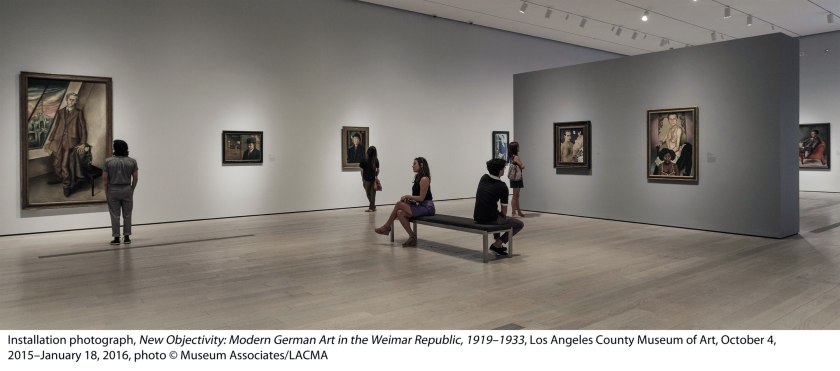
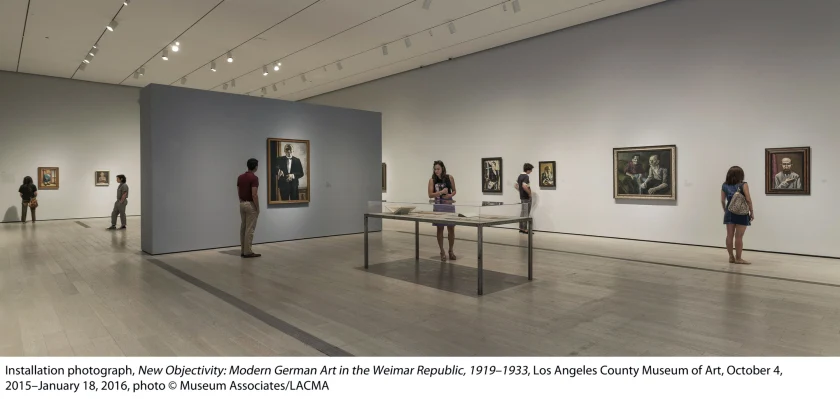
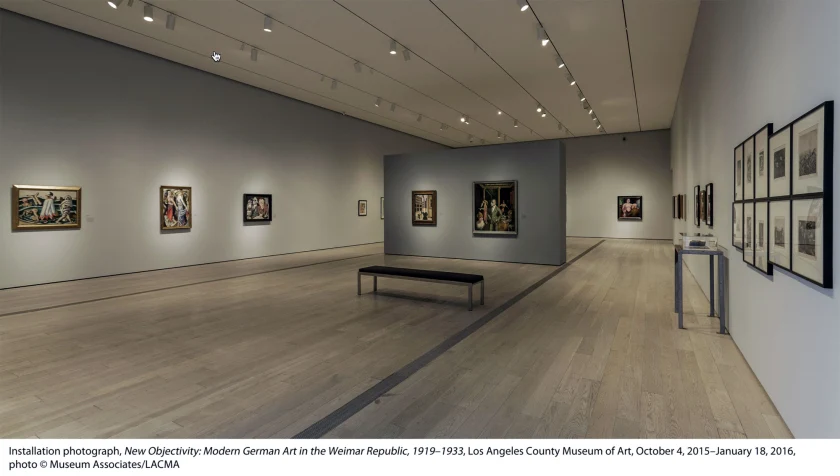

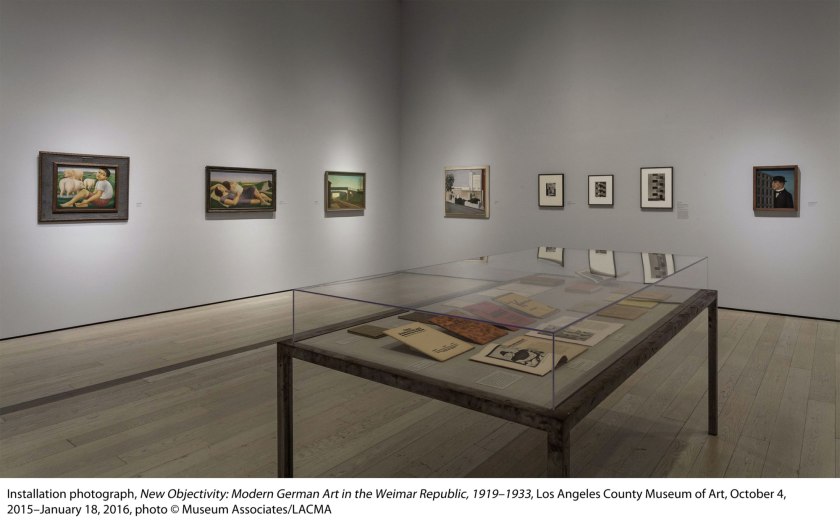

Installation photograph, New Objectivity: Modern German Art in the Weimar Republic, 1919-1933, with in the bottom image, a photo mural showing the exterior of famous Berlin nightclub Eldorado, Los Angeles County Museum of Art, October 4, 2015 – January 18, 2016, photo © Museum Associates/LACMA

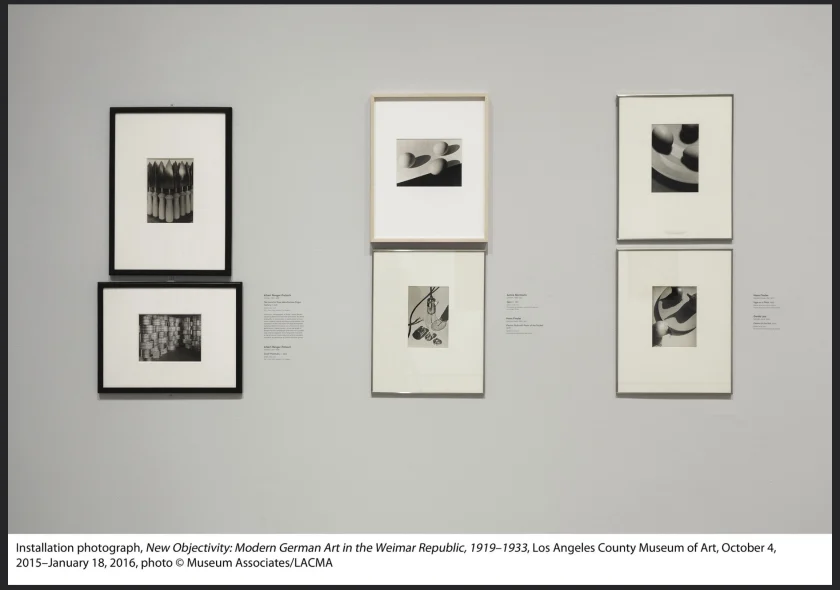

Installation photograph, New Objectivity: Modern German Art in the Weimar Republic, 1919-1933, showing photographs by Albert Renger-Patzsch (left), Aenne Biermann (centre top) and Hans Finsler (centre bottom), and Hans Finsler (right top) and Gerda Leo (bottom right), Los Angeles County Museum of Art, October 4, 2015 – January 18, 2016, photo © Museum Associates/LACMA

Installation photograph, New Objectivity: Modern German Art in the Weimar Republic, 1919-1933, showing photographs by August Sander.

Installation photograph, New Objectivity: Modern German Art in the Weimar Republic, 1919-1933, showing Aenne Biermann, Woman with Monocle (Dame mit Monokel), c. 1928 at left, with photographs by Friedrich Seidenstücker (right top) and Franz Roh (right bottom)
Exhibition themes
New Objectivity is divided into five sections that address the competing and, at times, conflicting approaches that the adherents to this new realism applied to the turbulent and ever-changing Weimar years.
The first section, Life in the Democracy and the Aftermath of the War, highlights the disparity between victims of the Weimar Republic and the growing bourgeoisie that benefited from the deprivation of that period. Artists such as Max Beckmann, Otto Dix, George Grosz, August Sander, and Heinrich Maria Davringhausen, portrayed urban landscapes highlighting postwar outcasts and their environs: the unemployed, disfigured, victims of violence, and prostitutes are set amid backdrops of bordellos, street corners and other scenes fraught with menace. In contrast, the Weimar Republic’s burgeoning upper class was often depicted as corrupt and ruthless. Davringhausen’s The Profiteer (1920-1921), for example, caricatures a common social type of the early Weimar era: the exploitative businessman making his fortune during the period of hyperinflation. Davringhausen places his profiteer on the top floor of a skyscraper in a long, narrow room filled with windows that appear to be left open, as if there may be the danger of falling out. The brick red walls add to the psychological intensity of the hyper-modern space, in which the well-dressed businessman sits at his desk, enjoying a glass of wine and a cigar as he stares out dispassionately, avoiding the viewer’s gaze.
In The City and the Nature of Landscape, artists respond to the tensions caused by the effects of industrialisation, which bled from cities into rural areas. As factories and jobs proliferated, Germany experienced a mass migration of its population from the countryside to urban areas. The notion of the city became associated with the future while the rural was nostalgically regarded as the past, and those who experienced the transition of migration were subject to feelings of displacement. The complex relationship between the urban and rural reflected the disparate conditions of the Weimar Republic. In addition to artists such as Leonhard Schmidt, Gustav Wunderwald, Erich Wegner, Georg Scholz, and Anton Räderscheidt, this section features Arthur Köster, whose photographs of architect Otto Haesler’s Georgsgarten Siedlung represented architectural spaces using high-contrast lighting and experimental framing. In St. Georgs-Garten Siedlung, Architekt Otto Haesler, Köster’s human subjects, dwarfed by the buildings’ geometric rigour and frozen in the composition’s overriding sense of stillness, suggest an apprehension toward the new, modernised Germany; meanwhile, his images portraying the green spaces of Georgsgarten Siedlung distill nature through the lens of industry.
Still Life and Commodities proposes a new form of the still life, meticulously staged compositions that might be called object-portraits. Zeroing in on disparate, banal objects of everyday life, these images represent things as markers of modernity and mass production. This section sees a recurring motif of cacti and rubber plants – “exotic” plants that were common in households at the time – and includes work by Aenne Biermann, Georg Scholz, Albert Renger-Patzsch, and Finsler, among others.
Man and Machine, the penultimate section of New Objectivity, highlights artists’ attention to the Weimar Republic’s advancements in technology and industry. While some were skeptical about the lack of humanity found within networks of new machinery, others acknowledged the transformative power of technologies and sought new ways of conceiving man’s relationship to industry. Photography plays a key role in this section, not only commenting on its newly accepted position as an art form, but also serving as a key influence for painters such as Carl Grossberg, who executed paintings of factories with photographic precision as seen in Paper Machine (1934). Additionally, some artists, such as Renger-Patzch, attempted to bridge the psychological divide between the natural and the industrial by drawing structural parallels between machinery and botany.
The final section of New Objectivity is dedicated to New Identities: Type and Portraiture, which examines the way artists including Beckmann, Dix, Schad, and their peers turned to portraiture. While diverse in approach, the portraits featured numerous commonalities, including social typecasting, unsentimental renderings, and self-portraiture. Dominating these portraits are depictions of other artists, writers, and performers, the working class, and marginalsed members of society as well as newly established types specific to the period, such as the war veteran and the “new woman.” One of the most iconic images to derive from this new trend informal realism is Max Beckmann’s Self-Portrait in Tuxedo (1927) in which he wears a smoking jacket and its class connotations like a costume and stares brazenly at the viewer. Another of the most important practitioners of this new portraiture is August Sander, who photographed his many subjects in somber, unexpressive poses, which he then arranged according to profession. The faces captured in his unfinished series – his subjects are only rarely identified by name – form an indelible archive of Weimar society.
Text from the LACMA press release
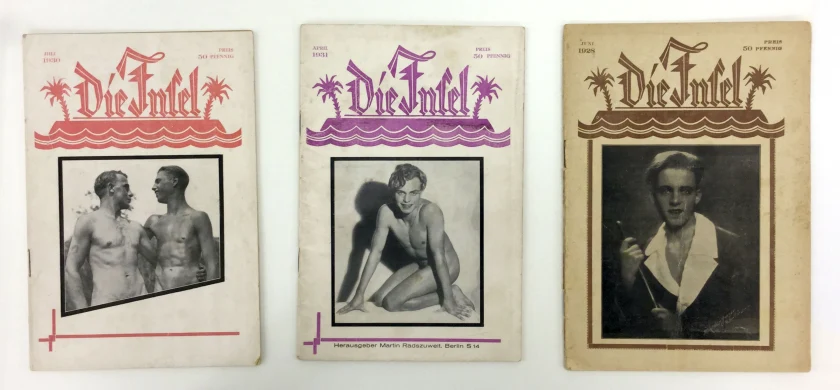
Die Insel (The Island), L-R: June 1928, July 1930, April 1931
Schwules Museum, Berlin
Photo by Nana Bahlmann

Die Freundin (The Girlfriend), September 1932, and Liebende Frauen (Women in Love), 1929
Spinnboden Berlin
Photo by Nana Bahlmann

Niels Hoyer (editor)
Lili Elbe. Ein Mensch wechseit sein Geschlecht (Man into Woman The First Sex Change)
1932
Los Angeles County Museum of Art
Photo by Nana Bahlmann
Lili Ilse Elvenes, better known as Lili Elbe (28 December 1882 – 13 September 1931), was a Danish transgender woman and one of the first identifiable recipients of sex reassignment surgery. Elbe was born Einar Magnus Andreas Wegener and was a successful artist under that name. She also presented as Lili, sometimes spelled Lily, and was publicly introduced as Einar’s sister. After transitioning, however, she made a legal name change to Lili Ilse Elvenes and stopped painting.
Elbe met Gerda Gottlieb at the Royal Danish Academy of Fine Arts in Copenhagen, and they married in 1904, when Gottlieb was 19 and Wegener was 22. The two of them worked as illustrators, with Elbe specialising in landscape paintings, while Gottlieb illustrated books and fashion magazines. They both travelled through Italy and France, eventually settling in Paris in 1912, where Elbe could live openly as a woman, and Gottlieb a lesbian. Elbe received the Neuhausens prize in 1907 and exhibited at Kunstnernes Efterårsudstilling (the Artists Fall Exhibition), at the Vejle Art Museum, and in the Saloon and Salon d’Automme in Paris. She is represented at Vejle Art Museum in Denmark.
Elbe started dressing in women’s clothes one day filling in for Gottlieb’s absentee model; she was asked to wear stockings and heels so her legs could substitute for those of the model. Elbe felt surprisingly comfortable in the clothing. Over time, Gottlieb became famous for her paintings of beautiful women with haunting almond-shaped eyes dressed in chic fashions. In 1913, the unsuspecting public was shocked to discover that the model who had inspired Gottlieb’s depictions of petites femmes fatales was in fact Gottlieb’s spouse, “Elbe”.
In 1930, Elbe went to Germany for sex reassignment surgery, which was experimental at the time. A series of four operations was carried out over a period of two years. The first surgery, removal of the testicles, was made under the supervision of sexologist Magnus Hirschfeld in Berlin. The rest of Elbe’s surgeries were carried out by Kurt Warnekros, a doctor at the Dresden Municipal Women’s Clinic. The second operation was to implant an ovary onto her abdominal musculature, the third to remove the penis and the scrotum, and the fourth to transplant a uterus and construct a vaginal canal. At the time of Elbe’s last surgery, her case was already a sensation in newspapers of Denmark and Germany. A Danish court invalidated the Wegeners’ marriage in October 1930, and Elbe managed to get her sex and name legally changed, including receiving a passport as Lili Ilse Elvenes…
In June 1931, Elbe had her fourth operation, which consisted of a uterus transplant and the construction of a vagina, both of which were new and experimental procedures at that time. She died three months after the surgery due to heart paralysis caused by the uterus transplant.
Text from the Wikipedia website

Der Eigene (The Unique)
1925
Schwules Museum, Berlin
Photo by Nana Bahlmann
Der Eigene was one of the first gay journals in the world, published from 1896 to 1932 by Adolf Brand in Berlin. Brand contributed many poems and articles; other contributors included writers Benedict Friedlaender, Hanns Heinz Ewers, Erich Mühsam, Kurt Hiller, Ernst Burchard, John Henry Mackay, Theodor Lessing, Klaus Mann, and Thomas Mann, as well as artists Wilhelm von Gloeden, Fidus, and Sascha Schneider. The journal may have had an average of around 1500 subscribers per issue during its run, but the exact numbers are uncertain.
Text from the Wikipedia website
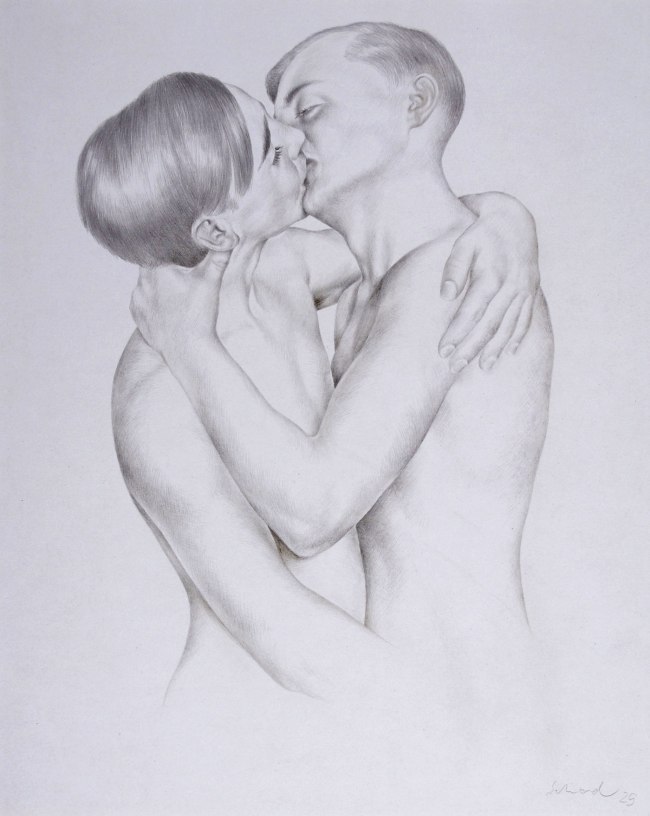
Christian Schad (German, 1894-1982)
Boys in Love (Liebende Knaben)
1929
Silverpoint
11 13/16 x 9 1/4 in. (30 x 23.5cm)
Museen der Stadt Aschaffenburg, Christian Schad Stiftung Aschaffenburg, Leihgabe der Kurt-Gerd-Kunkel Stiftung Aschaffenburg, MSA Dep. KGKS 1/1986
© 2015 Christian-Schad-Stiftung Aschaffenburg/Artists Rights Society (ARS), New York/VG Bild-Kunst, Bonn
Christian Schad (German, 1894-1982)
Self-Portrait with Model (Selbstbildnis mit Modell)
1927
Oil on wood
29 15/16 x 24 3/16 in. (76 x 61.5cm)
Private collection, courtesy of Tate
© 2015 Christian Schad Stiftung Aschaffenburg/Artists Rights Society (ARS), New York/VG Bild-Kunst, Bonn
Photo by Benjamin Hasenclever, Munich
Christian Schad (August 21, 1894 – February 25, 1982) was a German painter associated with Dada and the New Objectivity movement. Considered as a group, Schad’s portraits form an extraordinary record of life in Vienna and Berlin in the years following World War I.
Schad’s art was not condemned by the Nazis in the way that the work of Otto Dix, George Grosz, Max Beckmann, and many other artists of the New Objectivity movement was; this may have been because of his lack of commercial success. He became interested in Eastern philosophy around 1930, and his artistic production declined precipitously. After the crash of the New York stock market in 1929, Schad could no longer rely on his father’s financial support, and he largely stopped painting in the early 1930s. In 1937, unknown to him, the Museum of Modern Art showed three Schadographs, given by Tristan Tzara, in a show about Dada and Surrealism. The same year, Nazis included Schad in Great German Art, their antidote to the Degenerate Art show.
Schad lived in obscurity in Germany through the war and after it. After the destruction of his studio in 1943 Schad moved to Aschaffenburg. The city commissioned him to copy Matthias Grünewald’s Virgin and Child (Stuppach, parish church), a project on which he worked until 1947. Schad continued to paint in the 1950s in Magic Realist style and returned in the 1960s to experiments with photograms. Schad’s reputation did not begin to recover until the 1960s, when a couple of shows in Europe dovetailed with the rise of Photorealism.
Text from the Wikipedia website

Rudolf Schlichter (German, 1890-1955)
Meeting of Fetishists and Maniacal Flagellants (Zusammenkunft von Fetischisten und manischen Flagellanten)
c. 1921
Watercolour on paper
17 5/16 x 10 3/4 in. (43.9 x 27.3cm)
Private Collection
© Viola Roehr v. Alvensleben, Munich
Photo by Christian Wirth, Munich
Meeting of Fetishists and Maniacal Flagellants (1921) is a group fantasy of clothed males, half-naked women, old men masturbating and young women with knee-high boots flashing what Mick Jagger once called “far away eyes”.
Rudolf Schlichter (or Rudolph Schlichter) (December 6, 1890 – May 3, 1955) was a German painter and one of the most important representatives of the Neue Sachlichkeit (New Objectivity) movement.
Schlichter was born in Calw, Württemberg. After an apprenticeship as an enamel painter at a Pforzheim factory he attended the School of Arts and Crafts in Stuttgart. He subsequently studied under Hans Thoma and Wilhelm Trübner at the Academy in Karlsruhe. Called for military service in World War I, he carried out a hunger strike to secure early release, and in 1919 he moved to Berlin where he joined the Communist Party of Germany and the “November” group. He took part in a Dada fair in 1920 and also worked as an illustrator for several periodicals.
A major work from this period is his Dada Roof Studio, a watercolour showing an assortment of figures on an urban rooftop. Around a table sit a woman and two men in top hats. One of the men has a prosthetic hand and the other, also missing a hand, appears on closer scrutiny to be mannequin. Two other figures in gas masks may also be mannequins. A child holds a pail and a woman wearing high button shoes (for which Schlichter displayed a marked fetish) stands on a pedestal, gesturing inexplicably.
In 1925 Schlichter participated in the “Neue Sachlichkeit” exhibit at the Mannheim Kunsthalle. His work from this period is realistic, a good example being the Portrait of Margot (1924) now in the Berlin Märkisches Museum. It depicts a prostitute who often modelled for Schlichter, standing on a deserted street and holding a cigarette.
When Adolf Hitler took power, bringing to an end the Weimar period, his activities were greatly curtailed. In 1935 he returned to Stuttgart, and four years later to Munich. In 1937 his works were seized as degenerate art, and in 1939 the Nazi authorities banned him from exhibiting. His studio was destroyed by Allied bombs in 1942.
At the war’s end, Schlichter resumed exhibiting works. His works from this period were surrealistic in character. He died in Munich in 1955.
Text from the Wikipedia website
![Gert Wollheim (German, 1894-1974) 'Untitled (Couple)' (Ohne Titel [Paar]), 1926 Gert Wollheim (German, 1894-1974) 'Untitled (Couple)' (Ohne Titel [Paar]), 1926](https://artblart.files.wordpress.com/2016/01/wollheim-untitled.jpg?w=650&h=879)
Gert Wollheim (German, 1894-1974)
Untitled (Couple) (Ohne Titel [Paar])
1926
Oil on canvas
39 1/2 x 29 1/2 in. (100.3 x 74.9cm)
The Jewish Museum, New York, gift of Charlotte Levite in memory of Julius Nassau, 1990-1930
Photo: The Jewish Museum, New York/Art Resource, NY by John Parnell
Immediately after Hitler’s seizure of power in 1933 his works were declared degenerate art and many were destroyed. He fled to France and became active in the Resistance. He was one of the co-founders of the artists’ federation, the Union des Artistes Allemandes Libres, an organisation of exiled German artists founded in Paris in autumn 1937. In that same year, he became the companion of the dancer Tatjana Barbakoff. Meanwhile, in Munich, three of his pictures were displayed in the defamatory Nazi exhibition Entartete Kunst (Degenerate Art) in 1937.
From Paris, he fled to Saarbrücken and later to Switzerland. He was arrested in 1939 and held in a series of labor camps in France (Vierzon, Ruchard, Gurs and Septfonds) until his escape in 1942, after which he and his wife hid in the Pyrénées with the help of a peasant woman. At war’s end in 1945 he returned to France, and in 1947 moved to New York and became an American citizen. He died in New York in 1974.
Text from the Wikipedia website
Homosexuality Is a German Invention
Nana Bahlmann, Assistant Curator, Contemporary Exhibitions
December 14, 2015
Homosexuality was invented in Germany? While this might at first sound like a rather preposterous proposition, the idea of an identity based on a fixed sexual orientation did indeed originate in Germany. The public discourse and political movement supporting this idea also started in Germany, in Berlin in particular, and not, as one might assume, in London or New York. As Robert Beachy describes in his recent groundbreaking book Gay Berlin: Birthplace of a Modern Identity (2014), even the term HOMOSEXUALITÄT itself was a German invention, first appearing in a German language pamphlet in 1869. Although the origins of the movement date back to the 19th century, it was during the Weimar Republic (1919-1933), with its new social and democratic freedoms, that gay life experienced its unprecedented heyday. Despite the fact that sexual acts between men (women were simply not addressed) were still criminalized by Paragraph 175 of the penal code, homosexual men and women were able to express their identity more visibly than ever before. By the mid-1920s, around fifty thousand gays and lesbians lived in Berlin. With its countless nightclubs and meeting points for homosexuals, bisexuals, or transvestites, the city became a true “Eldorado” for this growing and vibrant community.
Our exhibition, New Objectivity: Modern German Art in the Weimar Republic, 1919-1933 (on view until January 18, 2016), devotes a whole section to these new social identities of the Weimar Republic. Here you will find stunning paintings and photographs depicting the so-called New Woman, with her bob, monocle, cigarette, and overall masculine demeanor, next to striking renderings of even more androgynous types, whose gender identity is ambiguous and even inscrutable at times. Look at Gert Wollheim’s Couple (1926, above), for instance, who might have come straight out of the popular nightclub Eldorado. With its transvestite hostesses, the infamous establishment attracted an illustrious crowd from all over Europe and featured performances by the likes of Marlene Dietrich. A contemporary visitor described the clientele of the famous cabaret as follows: “… you had lesbians looking like beautiful women, lesbians dressed exactly like men and looking like men. You had men dressed like women so you couldn’t possibly recognise they were men (…) Then you would see couples dancing and wouldn’t know anymore what it was.”
Or look at Christian Schad’s extraordinary Boys in Love (1929, above). This exquisite silverpoint drawing is a rare rendering of male homosexuality. The tenderness of the embrace is astonishing and congruent with the delicate subject matter. The loving intimacy between men so sensitively represented here seems even more provocative than a more explicit depiction of homosexual acts.
To illustrate the vast and far-reaching discourse surrounding the new identities of the Weimar Republic and to introduce the main protagonists defining and steering the movement, we are presenting books, magazines, and other ephemeral objects alongside the artworks. The vitrines in the exhibition include publications by the influential physician and sexologist Magnus Hirschfeld, a pioneer and principal advocate of homosexual and transgender rights. The so-called “Einstein of Sex” founded the Scientific Humanitarian Committee, the first gay-rights organisation and gathered more than five thousand signatures to overturn Paragraph 175. His prolific empirical research resulted in the publication of several anthologies examining gender and sexual identity and in the founding of the Institute for Sexual Research in Berlin, a museum, clinic, meeting point, and research centre. There, in 1930, the first sex reassignment surgery in history was performed on Lili Elbe (previously Einar Wegener). This process is chronicled in the book Man into Woman, also displayed in the exhibition and the basis for the film The Danish Girl directed by Tom Hooper, which is currently playing in theatres across America.
Shining a light on the various publications – over thirty at the time – for homosexuals, bisexuals, transsexuals, and transvestites, a selection of the most important gay and lesbian magazines is also presented in these vitrines. They include Der Eigene (The Unique), the first gay journal in the world. Published from 1896 until 1932 by Adolf Brand, it featured texts about politics and homosexual rights, literature, art, and culture, as well as aesthetic nude photography. Der Eigene was followed by many other gay magazines like Friedrich Radzuweit’s Die Insel (The Island). Surprisingly, these publications were displayed publicly and sold at newsstands alongside other mainstream papers. They included advertisements and announcements for various kinds of nightspots and meeting points, catering to the respective preferences of their readers.
Throughout the 1920s, Radzuweit, who was also an important homosexual rights activist and author, established a publishing network for gay and lesbian magazines. In 1924 he issued Die Freundin (The Girlfriend: Journal for Ideal Friendship between Women), the first lesbian magazine, for instance, and later Das dritte Geschlecht (The Third Gender). After his death in 1932, his son Martin took over the business. Other lesbian magazines presented here are Liebende Frauen (Women in Love), and Frauenliebe (Women Love).
With Hitler’s assumption of power in 1933, the vibrant movement came to an abrupt and brutal end. The Nazis immediately raided Hirschfeld’s Institute for Sexual Research and burned its archives. Wisely, Hirschfeld had not returned from a speaking tour and remained in exile until his death in 1935. Gay publications and organisations were banned and homosexuals were incarcerated, sent to concentration camps, or murdered; the Nazis eradicated the achievements and memories of this pioneering movement in Germany. We are happy to bring it back to life here in our exhibition at LACMA.
Nana Bahlmann. “Homosexuality Is a German Invention,” on the LACMA website, December 14, 2015 [Online] Cited 06/02/2016.
Georg Schrimpf (German, 1889-1938)
Reclining Girls in the Countryside (Liegende Mädchen im Grünen)
1930
Oil on canvas
21 1/4 × 39 3/4 in. (54 × 101cm)
Staatsgalerie Stuttgart
Photo © 2015 Staatsgalerie Stuttgart
Georg Schrimpf (13 February 1889 – 19 April 1938) was a German painter and graphic artist. Along with Otto Dix, George Grosz and Christian Schad, Schrimpf is broadly acknowledged as a main representative of the art movement Neue Sachlichkeit (usually translated New Objectivity), which developed, in Weimar Germany, from 1919 to 1933, as an outgrowth of Expressionism. Schrimpf was listed as a producer of Degenerate Art by the German National Socialist government in the 1930s.
Friedrich Seidenstücker (German, 1882-1966)
Untitled
c. 1930
Vintage print
6 15/16 x 5 1/16 in. (17.6 x 12.9cm)
Galerie Berinson, Berlin
Photo: Galerie Berinson, Berlin
Friedrich Seidenstücker (1882-1966) is noted for his atmospheric photographs of everyday life in Berlin during the Weimar Republic. Thanks to his compassionate studies of animals, he has an almost legendary reputation among animal and zoo lovers, and his haunting pictures of Berlin in ruins are a precious source of material for historians. His images seem to be spontaneous, sympathetic examples of the kind of photography that excels at capturing the moment. They are free of any exaggeration or extravagance, and display a sense of humour rarely found in photography. His work is buoyed by a fundamental optimism, yet it does not ignore the harshness, poverty, and suffering that prevailed at that time.
Max Beckmann (German, 1884-1950)
Paris Society (Gesellschaft Paris)
1931
Oil on canvas
43 × 69 1/8 in (109.2 × 175.6cm)
Solomon R. Guggenheim Museum, New York
© 2015 Artists Rights Society (ARS), New York/VG Bild-Kunst, Bonn,
Photo © The Solomon R. Guggenheim Foundation, New York
“My pictures reproach God for his errors.”
“We have to lay our hearts bare, to the cries of people who have been lied to.”
~ Max Beckmann
Unlike several of his avant-garde contemporaries, Beckmann rejected non-representational painting; instead, he took up and advanced the tradition of figurative painting. He greatly admired not only Cézanne and Van Gogh, but also Blake, Rembrandt, and Rubens, as well as Northern European artists of the late Middle Ages and early Renaissance, such as Bosch, Bruegel, and Matthias Grünewald. His style and method of composition are partially rooted in the imagery of medieval stained glass.
Engaging with the genres of portraiture, landscape, still life, and history painting, his diverse body of work created a very personal but authentic version of modernism, one with a healthy deference to traditional forms. Beckmann reinvented the religious triptych and expanded this archetype of medieval painting into an allegory of contemporary humanity.
From his beginnings in the fin de siècle to the period after World War II, Beckmann reflected an era of radical changes in both art and history in his work. Many of Beckmann’s paintings express the agonies of Europe in the first half of the 20th century. Some of his imagery refers to the decadent glamor of the Weimar Republic’s cabaret culture, but from the 1930s on, his works often contain mythologized references to the brutalities of the Nazis. Beyond these immediate concerns, his subjects and symbols assume a larger meaning, voicing universal themes of terror, redemption, and the mysteries of eternity and fate.
Text from the Wikipedia website
Kurt Günther (German, 1893-1955)
Portrait of a Boy (Knabenbildnis)
1928
Tempera on wood
18 7/8 x 14 9/16 in. (48 x 37cm)
Staatliche Museen zu Berlin, Nationalgalerie
© 2015 Artists Rights Society (ARS), New York/VG Bild-Kunst, Bonn
Photo: bpk, Berlin/Staatliche Museen zu Berlin, Nationalgalerie/Art Resource, NY
Herbert Ploberger (German, 1902-1977)
Self-Portrait with Ophthalmological Models (Selbstbildnis mit ophthamologischen Lehrmodellen)
c. 1928-1930
Oil on canvas
19 11/16 x 15 3/4 in. (50 x 40cm)
Städtische Galerie im Lenbachhaus und Kunstbau, Munich
© 2015 Artists Rights Society (ARS), New York/Bildrecht, Vienna
August Sander (German, 1876-1964)
Coal Carrier, Berlin (Berliner Kohlenträger)
1929
Gelatin silver print
9 1/2 x 6 in. (24.1 x 15.2cm)
J. Paul Getty Museum, Los Angeles, 84.XM.126.52
© 2015 Die Photographische Sammlung/SK Stiftung Kultur-August Sander Archiv, Cologne/Artists Rights Society (ARS), New York
Sander’s Face of our Time was published in 1929. It contains a selection of 60 portraits from his series People of the 20th Century, and is introduced by an essay by Alfred Döblin titled “On Faces, Pictures, and their Truth.” Under the Nazi regime, his work and personal life were greatly constrained. His son Erich, who was a member of the left wing Socialist Workers’ Party (SAP), was arrested in 1934 and sentenced to 10 years in prison, where he died in 1944, shortly before the end of his sentence. Sander’s book Face of our Time was seized in 1936 and the photographic plates destroyed. Around 1942, during World War II, he left Cologne and moved to a rural area, allowing him to save most of his negatives. His studio was destroyed in a 1944 bombing raid. Thirty thousand of Sander’s roughly forty-thousand negatives survived the war, only to perish in an accidental fire in Cologne in 1946. Sander practically ceased to work as a photographer after World War II. He died in Cologne in 1964.
George Grosz (German, 1893-1959)
Portrait of Dr. Felix J. Weil (Bildnis Dr. Felix J. Weil)
1926
Oil on canvas
53 x 61 in. (134.6 x 154.9cm)
Los Angeles County Museum of Art, gift of Richard L. Feigen in memory of Gregor Piatigorsky Art
© 2015 Estate of George Grosz/Licensed by VAGA, New York, NY
Photo © 2015 Museum Associates/LACMA
August Sander (German, 1876-1964)
Painter’s Wife (Helene Abelen) (Frau des Malers Abelen)
1926
Gelatin silver print
9 x 6 7/16 in. (22.9 x 16.4cm)
© Die Photographische Sammlung/SK Stiftung Kultur-August Sander Archiv, Cologne/Artists Rights Society (ARS), New York
August Sander (German, 1876-1964)
The Architect (Hans Poelzig) (Der Architekt Hans Poelzig)
1928
Vintage print
11 7/16 x 7 11/16 in. (29.1 x 19.5cm)
Galerie Berinson, Berlin
© 2015 Die Photographische Sammlung/SK Stiftung Kultur – August Sander Archiv, Cologne/Artists Rights Society (ARS), New York
Photo: Galerie Berinson, Berlin
Otto Dix (German, 1891-1969)
The Jeweller Karl Krall (Der Juwelier Karl Krall)
1923
Oil on canvas
35 5/8 x 23 13/16 in. (90.5 x 60.5cm)
Von der Heydt-Museum Wuppertal, Germany
© 2015 Artists Rights Society (ARS), New York/VG Bild-Kunst, Bonn
Photo courtesy Von der Heydt-Museum Wuppertal, Germany
Otto Dix (German, 1891-1969)
Portrait of the Lawyer Hugo Simons (Porträt des Rechtsanwalts Hugo Simons)
1925
Tempera and oil on plywood
39 1/2 x 27 11/16 in. (100.3 x 70.3cm)
Montreal Museum of Fine Arts, purchase, grant from the Government of Canada under the terms of the Cultural Property Export and Import Act, gifts of the Succession J. A. DeSève, Mr. and Mrs. Charles and Andrea Bronfman, Mr. Nahum Gelber and Dr. Sheila Gelber, Mrs. Phyllis Lambert, the Volunteer Association and the Junior Associates of the Montreal Museum of Fine Arts, Mrs. Louise L. Lamarre, Mr. Pierre Théberge, the Museum’s acquisition fund, and the Horsley and Annie Townsend Bequest
© 2015 Artists Rights Society (ARS), New York/VG Bild-Kunst, Bonn
Photo: The Montreal Museum of Fine Arts, Brian Merrett
Wilhelm Schnarrenberger (German, 1892-1966)
Portrait of an Architect (Porträt eines Architekten)
1923
Oil on canvas
34 1/4 x 23 1/16 in. (87 x 58.5cm)
Städtische Galerie Karlsruhe, on loan from private collection
© 2015 Artists Rights Society (ARS), New York/VG Bild-Kunst, Bonn
Photo by Ernst Reinhold, Munich
Wilhelm Schnarrenberger (June 30, 1892 – April 12, 1966) was a German painter associated with the New Objectivity. He was born in Buchen. From 1911 to 1916 he studied at the Munich School of Arts and Crafts. He had his first solo exhibition in 1916 at Hans Goltz’ gallery in Munich. In that same year he began a period of military service.
By 1920 he had returned to Munich, where he contributed illustrations to magazines such as Simplicissimus and Wieland. In 1921 he was made a professor of commercial art at the Karlsruhe Academy and joined the “Rih” group of artists that included Karl Hubbuch, Rudolph Schlichter, and Georg Scholz. At about this time, he published a series of lithographs of meticulously rendered landscape scenes.
The influence of Henri Rousseau is evident in Schnarrenberger’s work of the early 1920s. Paintings such as Old Men Going for a Walk (1922) adopt a deliberately naive approach to composition and the depiction of the figures. By 1924, when Schnarrenberger painted The Friends, his work fully exemplified the New Objectivity style in its sharp-edged, dispassionate rendering of a prosaic contemporary scene. According to art historian Sergiusz Michalski, “Schnarrenberger almost demonstratively refrains from portraying an emotional link between the persons in the picture.”
In 1925 Schnarrenberger’s paintings were included in the Neue Sachlichkeit (“New Objectivity”) exhibition organised by Gustav Friedrich Hartlaub at the Kunsthalle in Mannheim. By 1929, Schnarrenberger had begun to paint in a looser style. His work met with official disfavour during the Nazi era: In 1933 he was dismissed from his teaching job, and in 1937 he was declared a degenerate artist. From 1938 until 1947 he lived in Lenzkirch. In 1947 he regained his position as a professor the Karlsruhe Academy, and he relocated to Karlsruhe in 1948. In 1955 he began exhibiting with the Baden-Wurttemberg Federation of Artists. He was awarded the Hans Thoma State Prize [de] in 1962. Schnarrenberger died in Karlsruhe in 1966.
Text from the Wikipedia website
Aenne Biermann (German, 1898-1933)
Woman with Monocle (Dame mit Monokel)
c. 1928
Gelatin silver print
7 1/4 x 5 1/5 in. (18.4 x 13cm)
Bayerische Staatsgemäldesammlungen, Munich, Pinakothek der Moderne
Photo: Bayerische Staatsgemäldesammlungen, Fotoarchiv
Max Beckmann (German, 1884-1950)
Self-Portrait in Tuxedo (Selbstbildnis im Smoking)
1927
Oil on canvas
54 15/16 x 37 5/8 in. (139.5 x 95.5cm)
Harvard Art Museums/Busch-Reisinger Museum, Association Fund
© 2015 Artists Rights Society (ARS), New York/VG Bild-Kunst, Bonn
Photo: Imaging Department © President and Fellows of Harvard College
Christian Schad (German, 1894-1982)
Agosta, “The Pigeon Chested Man,” and Rasha, “The Black Dove,” (Agosta, der Flügelmensch, und Rasha, die schwarze Taube)
1929
Oil on canvas
47 1/4 x 31 1/2 in. (120 x 80cm)
Private Collection, loan by courtesy of Tate Gallery London
© 2015 Christian Schad Stiftung Aschaffenburg/Artists Rights Society (ARS), New York/VG Bild-Kunst, Bonn
Jeanne Mammen (German, 1890-1976)
Chess Player (Schachspieler)
c. 1929-1930
Oil on canvas
27 9/16 × 31 11/16 in. (70 × 80.5cm)
Berlinische Galerie, Landesmuseum für Moderne Kunst, Fotografie und Architektur
© 2015 Artists Rights Society (ARS), New York/VG Bild-Kunst, Bonn
Jeanne Mammen (21 November 1890 – 22 April 1976) was a German painter and illustrator of the Weimar period. Her work is associated with the New Objectivity and Symbolism movements. She is best known for her depictions of strong, sensual women and Berlin city life.
Heinrich Maria Davringhausen (German, 1894-1970)
The Profiteer (Der Schieber)
1920-1921
Oil on canvas
47 1/4 x 47 1/4 in. (120 x 120cm)
Stiftung Museum Kunstpalast, Düsseldorf
© Renata Davringhausen
Photo © Stiftung Museum Kunstpalast-ARTOTHEK
Perhaps the best-known work from Davringhausen’s New Objectivity period is Der Schieber (The Black-Marketeer), a Magic realist painting of 1920-1921, which is in the Kunstmuseum Düsseldorf im Ehrenhof. Painted in acidulous colours, it depicts a glowering businessman seated at a desk in a modern office suite that foreshortens dramatically behind him. Although Davringhausen rarely presented social criticism in his work, in Der Schieber “the artist created the classic pictorial symbol of the period of inflation that was commencing.”
Otto Dix (German, 1891-1969)
To Beauty (An die Schönheit)
1922
Oil and collage on canvas
54 15/16 x 47 7/16 in. (139.5 x 120.5cm)
Von der Heydt-Museum Wuppertal, Germany
© 2015 Artists Rights Society (ARS), New York/VG Bild-Kunst, Bonn
Photo courtesy Von der Heydt-Museum Wuppertal, Germany
George Grosz (German, 1893-1959)
Eclipse of the Sun (Sonnenfinsternis)
1926
Oil on canvas
81 5/8 × 71 7/8 in. (207.3 × 182.6cm)
The Heckscher Museum of Art, Huntington, New York, Museum, Purchase Art
© 2015 Estate of George Grosz/Licensed by VAGA, New York, NY
Max Beckmann (German, 1884-1950)
Dance in Baden-Baden (Tanz in Baden-Baden)
1923
Oil on canvas
42 1/2 x 26 in. (108 x 66cm)
Bayerische Staatsgemäldesammlungen, Munich, Pinakothek der Moderne
© 2015 Artists Rights Society (ARS), New York/VG Bild-Kunst, Bonn
Photo: bpk, Berlin/Bayerische Staatsgemäldesammlungen/Art Resource, NY
Los Angeles County Museum of Art (LACMA)
5905 Wilshire Boulevard (at Fairfax Avenue)
Los Angeles, CA, 90036
Phone: 323 857 6000
Opening hours:
Monday, Tuesday, Thursday, Friday: 11am – 6pm
Saturday, Sunday: 10am – 7pm
Closed Wednesday

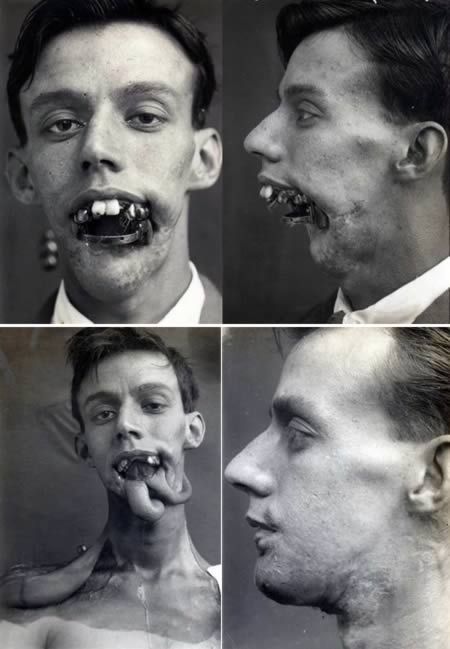



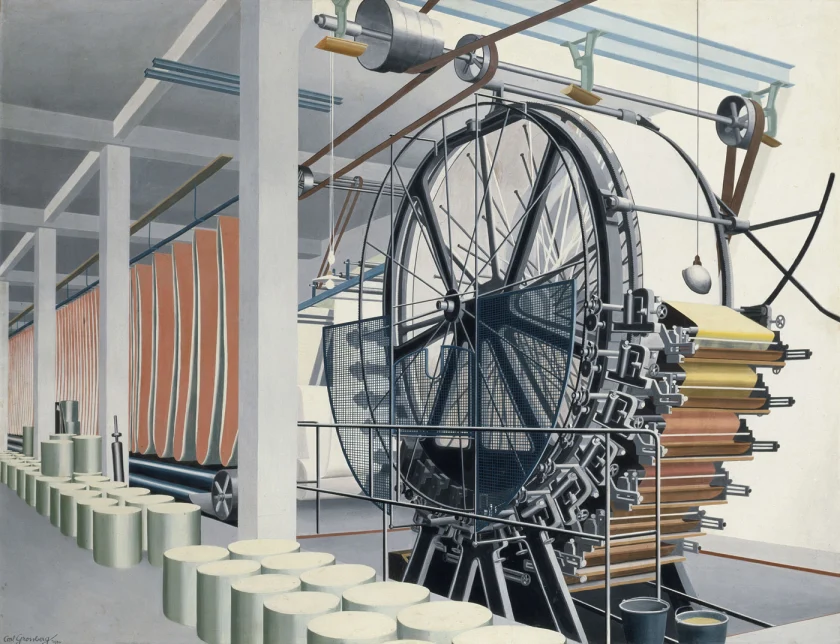








![George Grosz (German, 1893-1959) 'Construction (Untitled)' (Konstruktion [Ohne Titel]), 1920 George Grosz (German, 1893-1959) 'Construction (Untitled)' (Konstruktion [Ohne Titel]), 1920](https://artblart.files.wordpress.com/2016/01/grosz-construction.jpg?w=650&h=867)





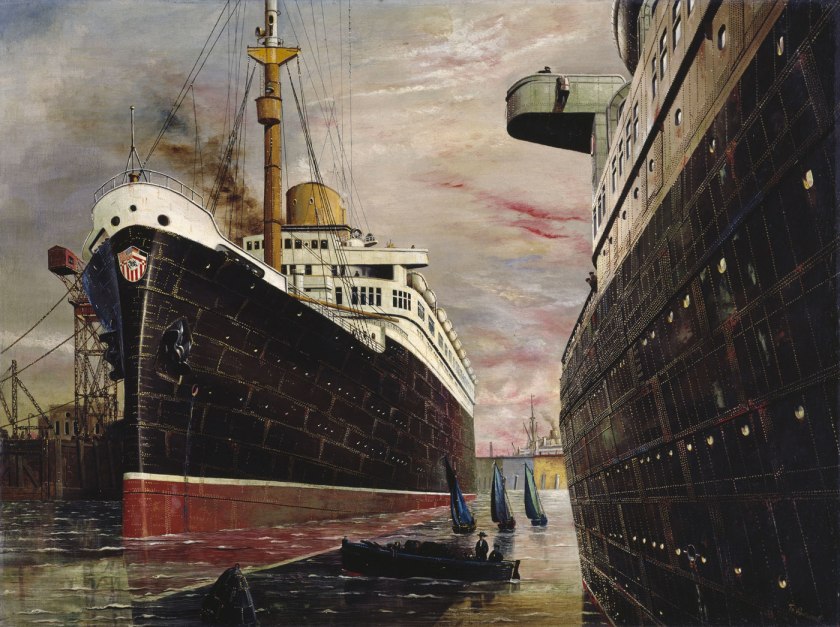
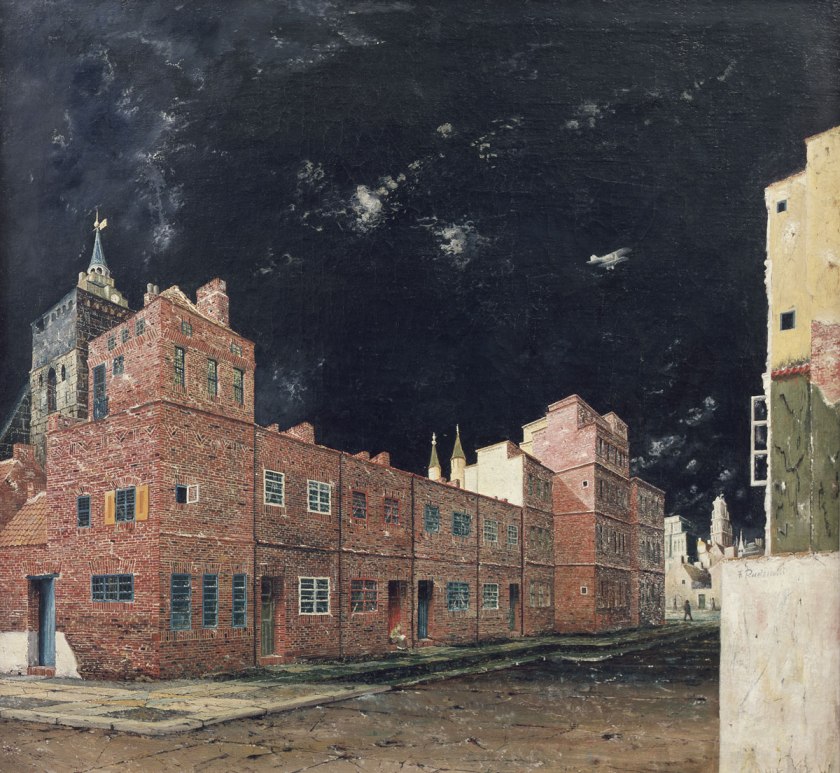

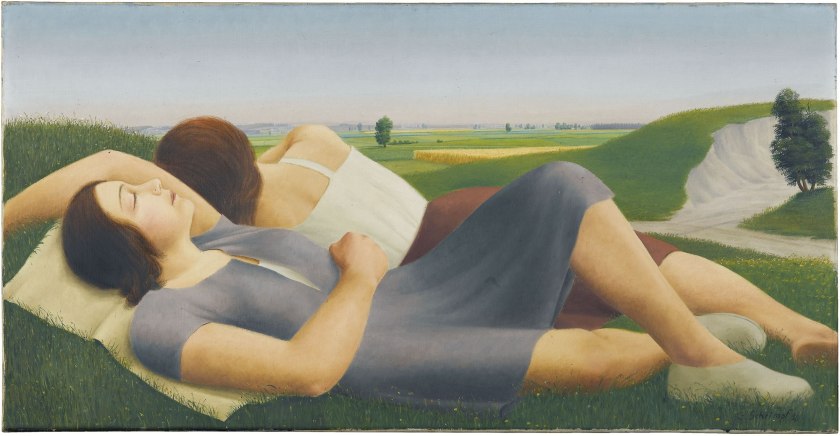

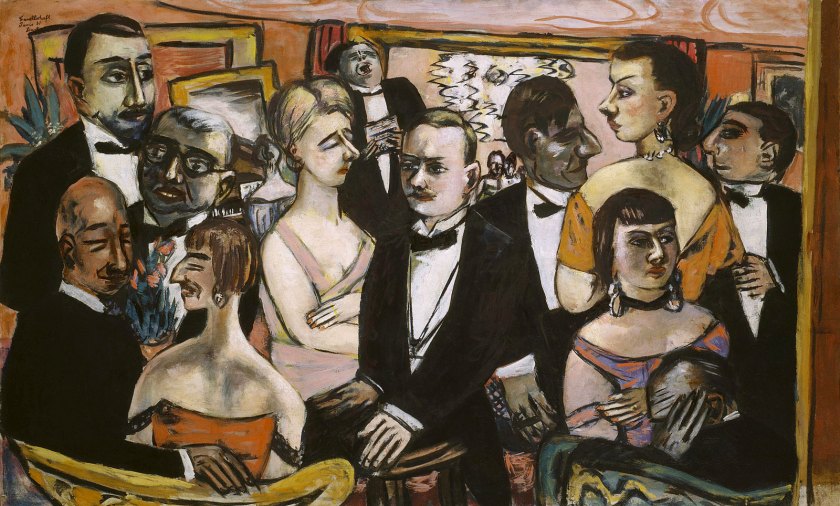



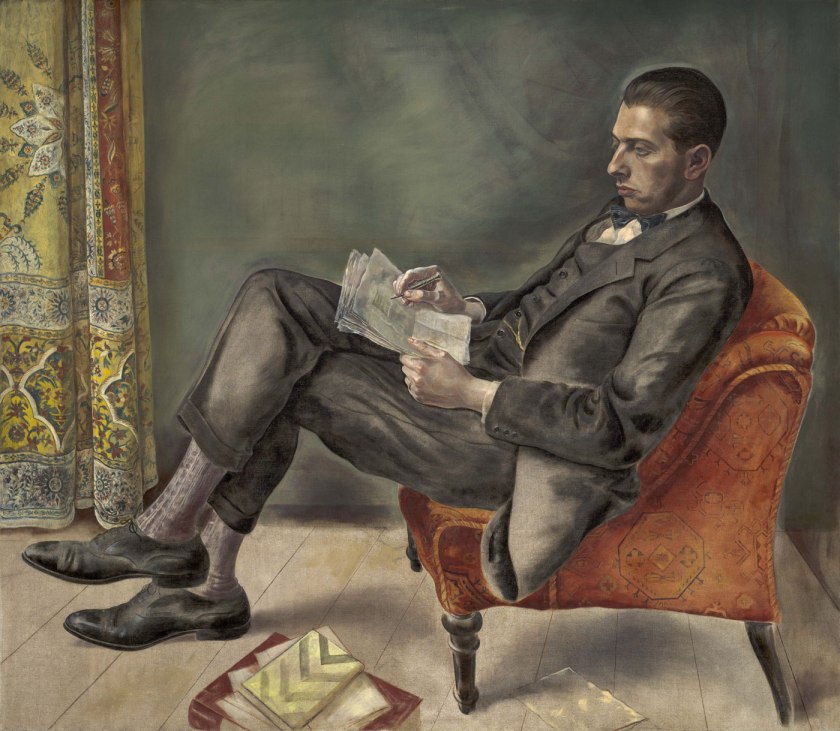













You must be logged in to post a comment.